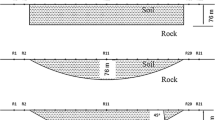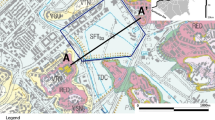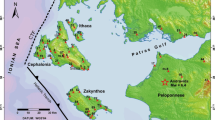Abstract
This paper presents the quantification of modification of ground motion due to urbanization in a 3D basin as compared to the free-field motion. The complex interaction effects of basin and city on the ground motion during an earthquake are termed as site–city interaction (SCI) effect in this paper. The cities were developed using 3D building blocks of sixteen-storey (city 1) and eight-storey (city 2) buildings. The analysis, in terms of ground motion perturbation and % reduction in average spectral amplification (ASA) and kinetic energy (KE) as compared to free-field motion, of the simulated responses of the various 3D basin-city models revealed very large role of basin shape, sediment layering, city shape, building type in the city and city density in the SCI effects on the free-field motion. The first spectral amplification peak frequency at the top of the buildings corroborates with the combined fundamental frequency of the building block and sediment deposit in basin. The obtained very large amplification of the order of 49 at the top of a single B8 building may be due to the closeness of the fundamental frequency of the combined basin-building system with the fundamental frequency of the basin and the dominant frequency in the input signal. This was also responsible for the larger % reduction in ASA and KE in city 2 (B8 buildings) as compared to the city 1 (B16 buildings). Based on the analysis of the obtained results, it is concluded that if a city is developed considering into account the building type, city shape and city density as per the basin shape and sediment parameters can be highly beneficial in reducing the earthquake disaster.





















Similar content being viewed by others
References
Bard PY, Bouchon M (1980) The seismic response of sediment filled valley, Part- I. The case of incident of SH waves. Bull Seismol Soc Am 70:1263–1286
Boutin C, Roussillon P (2004) Assessment of the urbanization effect on seismic response. Bull Seismol Soc Am 94(1):251–268
Chaljub E, Moczo P, Tsuno S, Bard PY, Kristek J, Kaser M, Stupazzini M, Kristekova M (2010) Quantitative comparison of four numerical predictions of 3D ground motion in the Grenoble Valley, France. Bull Seismol Soc Am 100:1427–1455
Chavez-Garcia FJ, Cardenas-Soto M (2002) The contribution of the built environment to the free-field ground motion in Mexico City. Soil Dyn Earthq Eng 22:773–780
Clouteau D, Aubry D (2001) Modification of ground motion in dense urban areas. J Comput Acoust 6:1659–1675
Cornou C, Gueguen P, Bard PY, Haghshenas E (2004) Ambient noise energy bursts observation and modeling: trapping of harmonic structure-soil induced–waves in a topmost sedimentary layer. J Seismol 8(4):507–524
Emmerich H, Korn M (1987) Incorporation of attenuation into time-domain computations of seismic wave fields. Geophysics 52:1252–1264
Foutch DA and Housner GW (1977) Observed changes in the natural periods of vibration of a nine story steel framed building. In: 6th WCEE, pp 2698–2704
Gallipoli MR, Mucciarelli M, Castro RR, Monachesi G, Contri P (2004) Structure, soil-structure response and effects of damage based on observations of horizontal-to-vertical spectral ratios of microtremors. Soil Dyn Earthq Eng 24:487–495
Gao S, Liu H, Davis PM, Knopoff GL (1996) Localized amplification of seismic waves and correlation with damage due to the Northridge earthquake. Bull Seismol Soc Am 86:S209–s230
Groby JP, Tsogka C, Wirgin A (2005) Simulation of seismic response in a city-like environment. Soil Dyn Earthq Eng 25(7–10):487–504
Gueguen P, Bard PY (2005) Soil-structure and soil-structure-soil interaction: experimental evidence at the Volvi test site. J Earthq Eng 9(5):657–693
Gueguen P, Bard PY, Oliveira CS (2000) Experimental and numerical analysis of soil motion caused by free vibration of a building model. Bull Seismol Soc Am 90:1464–1479
Guéguen P, Bard PY, Chavez-Garcia FJ (2002) Site-city interaction in Mexico City-like environments: an analytical study. Bull Seismol Soc Am 92(2):794–811
IS-1893 (Part 1) (2002) Criteria for earthquake resistant design of structures—Part 1: General provision and buildings. Bureau of Indian Standards
Israeli M, Orszag SA (1981) Approximation of radiation boundary conditions. J Comp Phys 41:115–135
Jennings PC (1970) Distant motion from a building vibration test. Bull Seismol Soc Am 60:2037–2043
Kamal, Narayan JP (2015) 3D basin-shape ratio effects on frequency content and spectral amplitudes of basin-generated surface waves and associated spatial ground motion amplification and differential ground motion. J Seismol. doi:10.1007/s10950-014-9466-8
Kanamori H, Mori J, Anderson DL, Heaton TH (1991) Seismic excitation by the space shuttle Columbia. Nature 349:781–782
Kham M, Semblat JF, Bard PY, Dangla P (2006) Seismic site–city interaction: main governing phenomena through simplified numerical models. Bull Seismol Soc Am 96:1934–1951
Kim WY, Sykes LR, Armitage JH, Xie JK, Jacob KH, Richards PG, West M, Waldhauser F, Armbruster J, Seeber L, Du WX, Lerner-Lam A (2001) Seismic waves generated by aircraft impacts and building collapses at World Trade Center, New York City. Eos Trans Am Geophys Union 82(47):570–571. doi:10.1029/01EO00330
Kristek J, Moczo P (2003) Seismic wave propagation in viscoelastic media with material discontinuities- a 3D 4th order staggered grid finite difference modeling. Bull Seismol Soc Am 93:2273–2280
Kumar S, Narayan JP (2008) Implementation of absorbing boundary conditions in a 4th order accurate SH-wave staggered grid finite difference program with variable grid size. Acta Geophys 56:1090–1108
Merritt RG, Housner GW (1954) Effect of foundation compliance on earthquake stresses in multi-story buildings. Bull Seismol Soc Am 44:551–569
Moczo P, Kristek J, Vavrycuk V, Archuleta RJ, Halada L (2002) 3D heterogeneous staggered-grid finite-difference modelling of seismic motion with volume harmonic and arithmetic averaging of elastic moduli and densities. Bull Seismol Soc Am 92:3042–3066
Narayan JP (2005) Study of basin-edge effects on the ground motion characteristics using 2.5-D modeling. Pure Appl GEOPHYS 162:273–289
Narayan JP (2012) Effects of P-wave and S-wave impedance contrast on the characteristics of basin transduced Rayleigh waves. Pure Appl Geophys 169:693–709
Narayan JP, Kumar V (2014a) P-SV wave time-domain finite-difference algorithm with realistic damping and a combined study of effects of sediment rheology and basement focusing. Acta Geophys 62:1214–1245
Narayan JP, Kumar R (2014b) Spatial spectral amplification of basin-transduced rayleigh waves. Nat Hazards 71:751–765
Narayan JP, Sahar D (2014) 3D viscoelastic finite-difference code and modelling of basement focusing effects on ground motion characteristics. Comput Geosci. doi:10.1007/s10596-014-9442-y
Narayan JP, Sharma ML, Kumar A (2002) A seismological report on the January 26, 2001 earthquake at Bhuj. India Seismol Res Lett 73:343–355
Sahar D, Narayan JP, Kumar N (2015) Study of role of basin-shape in the site-city-interaction effects on the ground motion characteristics. Nat Hazards. doi:10.1007/s11069-014-1366-2
Semblat JF, Kham M, Bard PY (2008) Seismic-wave propagation in alluvial basins and influence of site-city interaction. Bull Seismol Soc Am 98:2665–2678
Semblat JF, Lokmane N, Driad-Lebeau L, Bonnet G (2010) Local amplification of deep mining induced vibrations Part 2: Simulation of ground motion in a coal basin. Soil Dyn Earthq Eng 30(10):947–995
Stewart JP, Seed RB, Fenves GL (1999) Seismic soil-structure interaction in buildings, II: empirical findings. J Geotech Geo-environ Eng 125:38–48
Taborda R, Bielak J (2011) Large-scale earthquake simulation- Computational seismology and complex engineering systems. Comput Sci Eng 13:14–26. doi:10.1109/MCSE.2011.19
Tsogka C, Wirgin A (2003) Simulation of seismic response in an idealized city. Soil Dyn Earthq Eng 23:391–402
Wirgin A, Bard PY (1996) Effects of building on the duration and amplitude of ground motion in Mexico City. Bull Seismol Soc Am 86:914–920
Wolf JP (1985) Dynamic soil-structure interaction. Prentice-Hall Inc, Englewood Cliffs
Wong HL, Trifunac MD (1975) Two dimensional antiplane building-soil-building interaction for two or more buildings and for incident plane SH waves. Bull Seismol Soc Am 65:1863–1885
Zeng C, Xia J, Miller R, Tsoflias G (2012) An improved vacuum formulation for 2D finite-difference modeling of Rayleigh waves including surface topography and internal discontinuities. Geophysics 77:T1–T9
Acknowledgments
The second author is grateful to the Ministry of Earth Sciences, New Delhi, for financial assistance through Grant Number MES-484-EQD.
Author information
Authors and Affiliations
Corresponding author
Rights and permissions
About this article
Cite this article
Sahar, D., Narayan, J.P. Quantification of modification of ground motion due to urbanization in a 3D basin using viscoelastic finite-difference modelling. Nat Hazards 81, 779–806 (2016). https://doi.org/10.1007/s11069-015-2105-z
Received:
Accepted:
Published:
Issue Date:
DOI: https://doi.org/10.1007/s11069-015-2105-z




